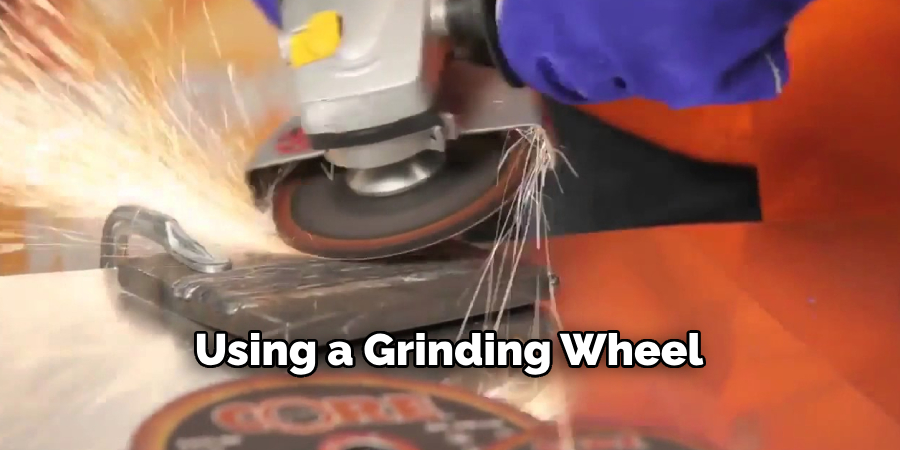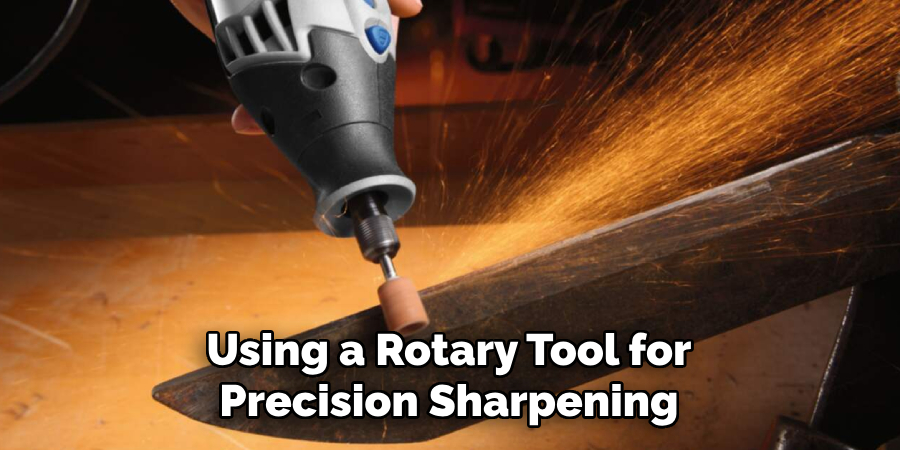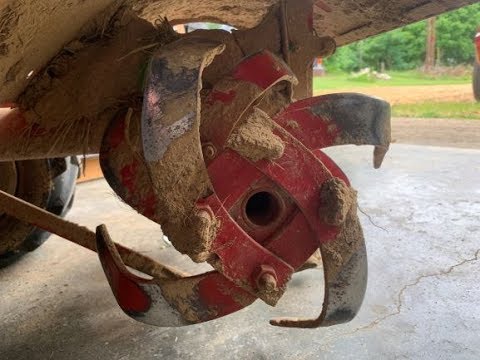To sharpen tiller blades, remove them from the tiller and file the edges with a handheld metal file. Proper maintenance of tiller blades is essential for ensuring efficient tilling performance.
Over time, tiller blades can become dull and lose their effectiveness. Sharpening the blades regularly not only improves their cutting ability but also extends their lifespan. Whether you are using a gas-powered, electric, or manual tiller, the process of sharpening the blades is relatively simple and requires basic tools.
By following a few simple steps, you can easily sharpen your tiller blades and keep your garden or farm productive. We will discuss the step-by-step process of how to sharpen tiller blades effectively.

Credit: gardeningproductsreview.com
Why Sharpening Tiller Blades Is Important
Tiller blades play a crucial role in efficient gardening by properly cultivating the soil. Maintaining sharp blades is essential for optimal performance. Watch out for signs that indicate the blades need sharpening, such as difficulty cutting through dense vegetation or leaving uneven furrows.
Regular maintenance not only extends the lifespan of the blades but also ensures smooth operation. Sharpening the blades increases their cutting efficiency, allowing for easier soil preparation and ultimately resulting in better seedbeds. By keeping the blades sharp, you can maximize the effectiveness of your tiller and achieve outstanding gardening results.
So, don’t overlook the importance of sharpening your tiller blades for a successful and productive gardening experience.
Tools And Materials Needed For Sharpening
When sharpening tiller blades, it is important to have the right tools and materials on hand. Essential tools for the job include a file or grinder, a flat work surface, and a vice or clamp to hold the blade securely in place.
Safety equipment recommendations include wearing safety goggles, gloves, and ear protection to protect yourself while working. Using quality materials is crucial for a successful sharpening process. A sharpening stone or sandpaper with a coarse grit is ideal for removing any nicks or burrs from the blade.
Once the blade is free of imperfections, a finer grit stone or sandpaper can be used to create a sharp cutting edge. Taking the time to properly sharpen your tiller blades will ensure optimal performance and longevity.
How to Sharpen Tiller Blades: Step by Step Guide
Preparing For The Sharpening Process
Preparing for the sharpening process involves properly disconnecting the tiller and creating a clean working area. Before starting, ensure that you take necessary safety precautions for handling the sharp blades. Disconnecting the tiller properly is essential to avoid any accidents.
Clean the area where you will be working to prevent any debris from interfering with the sharpening process. Once the tiller is disconnected and the area is clean, you can proceed with sharpening the blades. Remember to follow the manufacturer’s guidelines for the specific instructions on how to sharpen the tiller blades.
Regularly maintaining and sharpening the blades will ensure the tiller operates at its best and ensures optimal performance.
Removing And Inspecting The Tiller Blades
Removing and inspecting the tiller blades is a crucial step in maintaining its functionality. To start, follow the step-by-step process for removing the blades. Thoroughly inspect each blade to identify any issues that may affect its performance. After inspection, it is important to clean the blades before sharpening them.
Cleaning ensures that no debris or dirt interferes with the sharpening process. Taking the time to properly clean and inspect the blades will result in a more efficient and effective tiller. Keep these steps in mind to ensure the longevity and reliability of your tiller blades.
Choosing The Right Sharpening Method
Choosing the right method to sharpen tiller blades is essential for optimal performance. There are various techniques available, each with its own pros and cons. One approach is using a grinding wheel, which provides a precise edge but can be time-consuming.

Another option is using a file, which offers more control but requires manual effort. Additionally, a bench grinder can be used for quick sharpening, though it may remove more blade material. Moreover, there are sharpening kits available for ease and convenience.
However, it is important to consider the condition of the blades and the desired outcome when selecting a method. In this blog post, we will explore the different sharpening techniques, weigh their pros and cons, and help you choose the most suitable approach for your tiller blades.
Sharpening Tiller Blades With A File
Sharpening tiller blades with a file is an essential maintenance task for optimal performance. To begin, make sure you hold the file at the correct angle and apply consistent pressure as you work. Start from the outer edge of the blade and file towards the center in a sweeping motion.
Repeat this process on each side of the blade until you achieve a sharp edge. Remember to maintain the same number of strokes on each side to ensure even sharpness. To get the best results, it’s important to regularly clean and oil your file.
Additionally, be mindful of any nicks or damage on the blade surface that may require extra attention. By following these steps and tips, you can keep your tiller blades in top shape and improve their cutting efficiency.
Using A Bench Grinder To Sharpen Tiller Blades
Using a bench grinder is an effective way to sharpen tiller blades. Start by adjusting the settings for optimal sharpening. Follow detailed instructions and safety precautions to ensure a safe process. One important tip is to avoid overheating the blades, as it can cause damage.
Take breaks as needed to prevent this. Remember to keep the blades cool by frequently dipping them in water. This will also help achieve a sharper edge. Take your time and maintain a steady hand while sharpening. This will result in a more precise and efficient cutting performance.
Remember to always wear protective gear when working with a bench grinder. By following these steps, you can successfully sharpen your tiller blades and improve their durability and effectiveness.
Using A Rotary Tool For Precision Sharpening
Using a rotary tool for precision sharpening tiller blades offers many advantages. The tool’s versatility allows for precise and even sharpening, ensuring optimal performance. However, it is important to be aware of its limitations. One common mistake to avoid is applying too much pressure, which can damage the blades.

Instead, use a gentle and steady hand to achieve the desired results. Another common error is neglecting to clean the blades before sharpening. Remove any dirt or debris to avoid marring the sharpening process. Additionally, ensure that the blades are properly secured in the rotary tool to prevent accidents or injuries.
With these tips in mind, you can effectively sharpen your tiller blades and keep your equipment functioning at its best.
Balancing And Reinstalling The Tiller Blades
Blade balance is crucial for smooth operation when sharpening tiller blades. To achieve proper balance, follow these step-by-step instructions. First, ensure the blades are clean and free from debris. Next, carefully inspect each blade for signs of damage or wear.
Use a balancer to identify any imbalances and make necessary adjustments. Once balanced, reinstall the blades securely, following the manufacturer’s instructions. This ensures both efficiency and safety of the tiller. Remember to tighten all bolts and nuts properly, avoiding overtightening.
Finally, give the tiller a test run to ensure smooth operation. By balancing and reinstalling the blades correctly, you can extend their lifespan and improve overall tiller performance.
Testing And Fine-Tuning The Sharpened Blades
Testing and fine-tuning the sharpened tiller blades is crucial for optimal performance. After sharpening, conduct a thorough inspection to ensure their condition. Look for signs of damage or wear and make necessary adjustments. Additional adjustments may be needed to achieve the best results.
Remember to maintain the blades’ sharpness throughout the gardening season. Regularly check and sharpen them as needed to keep them in top shape. By following these tips, you can ensure that your tiller blades are always ready to tackle any gardening task efficiently.
Happy gardening!
Sharpening Frequency And Maintenance Tips
To ensure the longevity of your tiller blades, it is essential to maintain a regular sharpening routine. By following recommended frequency guidelines, you can keep your blades in optimal condition. In addition to sharpening, routine maintenance practices play a crucial role in extending the lifespan of your blades.
This includes regular cleaning, checking for damages or dents, and lubricating the moving parts. It is important to avoid common mistakes that can shorten the lifespan of the blades, such as using excessive force or operating the tiller on rocky terrain.
By taking these preventative measures, you can ensure that your tiller blades remain sharp and effective for a long time. So, make it a habit to regularly sharpen and care for your blades to enjoy efficient tilling operations.
Frequently Asked Questions On How To Sharpen Tiller Blades
How Often Do Tiller Blades Need To Be Sharpened?
Tiller blades should be sharpened at least once a year, but it may vary depending on usage and soil conditions. By maintaining a sharp cutting edge, you can ensure better performance and efficiency in your garden or farm.
What Tools Are Needed To Sharpen Tiller Blades?
To sharpen tiller blades, you’ll need a bench grinder or sharpening stone, safety goggles, gloves, and a wire brush. Ensure you have these tools handy before starting the sharpening process.
Can I Sharpen Tiller Blades Myself Or Should I Hire A Professional?
Sharpening tiller blades can be done yourself if you have the necessary tools and knowledge. However, if you lack experience or prefer professional assistance, hiring a tiller blade sharpening service is a viable option. Just make sure to choose a reliable service provider.
How Do I Know If My Tiller Blades Need Sharpening Or Replacement?
If you notice that your tiller is not cutting through soil easily or the quality of tilling has decreased, it’s a sign that the blades may need sharpening or replacement. Examine the blades for signs of wear, nicks, or dullness to make an accurate assessment.
What’S The Sharpening Process For Tiller Blades?
To sharpen tiller blades, start by removing them from the tiller. Use a bench grinder or sharpening stone to remove any burrs, nicks, or dullness from the cutting edge. Maintain a consistent angle and apply light pressure during the sharpening process.
Finally, reinstall the sharpened blades and test their performance.
Can I Use A File Instead Of A Bench Grinder To Sharpen Tiller Blades?
Using a file to sharpen tiller blades is possible, but it might not provide the same level of precision and efficiency as a bench grinder. A bench grinder ensures a more even and consistent sharpening result, making it the preferred option for most gardeners and farmers.
Conclusion
Sharpening tiller blades is a crucial part of maintaining a successful gardening or landscaping operation. By regularly sharpening the blades, you can ensure that your tiller operates efficiently and effectively, saving you time and effort in the long run. Remember to follow the proper safety precautions and use the recommended tools and techniques for the best results.
Whether you choose to sharpen the blades yourself or enlist the help of a professional, it’s important to prioritize this task in order to maximize the performance of your tiller. With sharp blades, you’ll be able to achieve optimal tilling depth and smooth operation, leading to a beautifully manicured garden or landscape.
So don’t neglect this essential maintenance step and enjoy the benefits of a well-sharpened tiller blade. Happy gardening!

